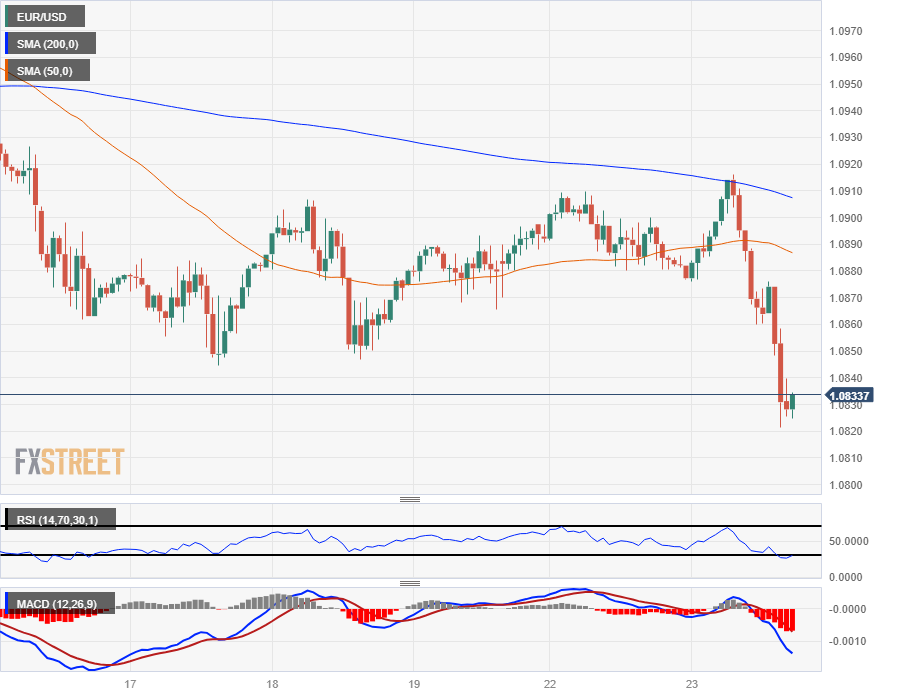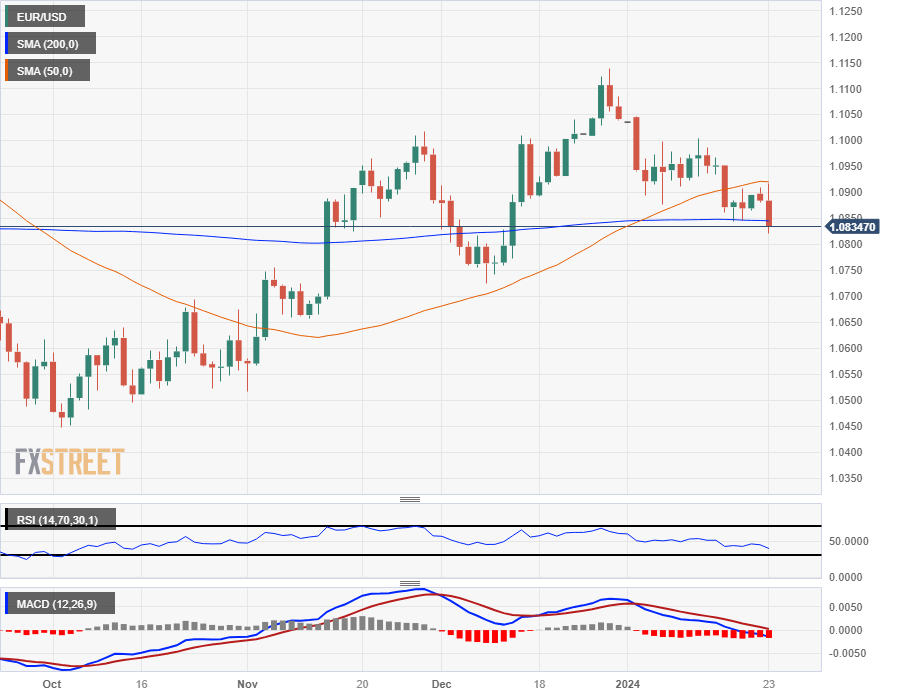- EUR/USD falls to five-week lows as safe-haven flows pick up in the dollar.
- The EU and US PMI indices will be published on Wednesday.
- ECB interest rates will be announced on Thursday and US CPI inflation on Friday.
The EUR/USD pair hit 2024 lows again, reaching the lowest levels in almost six weeks, after the Euro continued to fall in markets due to deteriorating consumer sentiment and a decline in bank lending, confirmed by the latest bank lending survey from the European Central Bank (ECB).
The Euro continued to fall in Europe after the ECB confirmed that business and credit activity in the Eurozone continued to decline. High interest rates compounded the overall decline in bank lending activity across the continent, with European banks tightening lending conditions again until the fourth quarter of 2023.
Daily Market Summary: EUR/USD Pulls Back as Negative Data Releases Pile Up
- The European Consumer Sentiment Index fell to -16.1 in January, compared to the expected rebound from -15.0 in December to 14.3.
- The Richmond Fed manufacturing index also fell in January to its lowest level in almost four years, standing at -15 compared to -11 in December and falling short of the -7 level expected by the market.
- The ECB's latest Bank Lending Survey showed that banks' lending activity continued to decline in the fourth quarter, with high interest rates and deteriorating consumer sentiment the main triggers.
- The ECB noted that European banks have generally tightened lending conditions, limiting access to credit, which had already seen a drop in demand.
- Global demand for loans, from both businesses and households, is expected to continue to decline in the first quarter of 2024.
- The decline in credit activity slowed in the fourth quarter, but continues to decelerate, aggravating the decline in economic activity.
- The Purchasing Managers' Index (PMI) figures for both the euro zone and the United States will be published on Wednesday.
- Markets expect the HCOB Pan-European Composite PMI to see a slight rise from 47.6 to 48.0.
- The euro zone composite PMI has been below 50.0 contraction points since July.
- The US services PMI is expected to decline slightly from 51.4 to 51.0.
- The ECB descends on the markets with its latest rate call on Thursday.
- Market expectations that the ECB will slash rates have been dampened by constant warnings from central bankers that market hopes for rate cuts have gone too far than policymakers expected. they can offer.
Euro price today
The following table shows the percentage variation of the Euro (EUR) against the main currencies. The Euro was the weakest currency against the US dollar.
| USD | EUR | GBP | CAD | AUD | JPY | NZD | CHF | |
| USD | 0.39% | 0.40% | 0.06% | 0.16% | 0.28% | 0.12% | 0.24% | |
| EUR | -0.40% | 0.01% | -0.34% | -0.23% | -0.12% | -0.27% | -0.15% | |
| GBP | -0.40% | -0.01% | -0.35% | -0.21% | -0.14% | -0.27% | -0.17% | |
| CAD | -0.08% | 0.32% | 0.33% | 0.09% | 0.19% | 0.04% | 0.16% | |
| AUD | -0.21% | 0.19% | 0.19% | -0.16% | 0.06% | -0.06% | 0.04% | |
| JPY | -0.28% | 0.11% | 0.12% | -0.21% | -0.07% | -0.13% | -0.03% | |
| NZD | -0.11% | 0.29% | 0.27% | -0.08% | 0.06% | 0.17% | 0.10% | |
| CHF | -0.26% | 0.14% | 0.16% | -0.19% | -0.04% | 0.03% | -0.11% |
The heat map shows the percentage changes of the major currencies against each other. The base currency is chosen in the left column, while the quote currency is chosen in the top row. For example, if you choose the euro in the left column and scroll down the horizontal line to the Japanese yen, the percentage change in the box will represent EUR (base)/JPY (quote).
Technical Analysis: EUR/USD sharply declines again from 1.0900
The EUR/USD fell below the 1.0900 zone on Tuesday for the third time in less than a week, after the pair suffered a strong rejection from the 200 hourly SMA near 1.0915, giving up further. of eight tenths from top to bottom.
With Tuesday's decline, the EUR/USD pair is heading towards the 200-day SMA, after moving away from the 50-day SMA near 1.0920. EUR/USD intraday volatility sees the pair consolidate between the 50-day and 200-day SMA, and if the decline continues, the pair will head towards the latest swing low near 1.0750.
EUR/USD Hourly Chart

EUR/USD Daily Chart
Frequently asked questions about the Euro
What is the Euro?
The Euro is the currency of the 20 countries of the European Union that belong to the euro zone. It is the second most traded currency in the world, behind the US dollar. In 2022, it accounted for 31% of all foreign exchange transactions, with an average daily volume of more than $2.2 trillion per day.
EUR/USD is the most traded currency pair in the world, accounting for an estimated 30% of all transactions, followed by EUR/JPY (4%), EUR/GBP (3%) and EUR/AUD (2% ).
What is the ECB and how does it influence the Euro?
The European Central Bank (ECB), headquartered in Frankfurt, Germany, is the reserve bank of the euro zone. The ECB sets interest rates and manages monetary policy
The ECB's main mandate is to maintain price stability, which means controlling inflation or stimulating growth. Its main instrument is to raise or lower interest rates. Relatively high interest rates – or the expectation of higher rates – tend to benefit the Euro and vice versa.
The Governing Council of the ECB takes monetary policy decisions at meetings held eight times a year. Decisions are made by the heads of the eurozone's national banks and six permanent members, including ECB President Christine Lagarde.
How do inflation data influence the value of the Euro?
Eurozone inflation data, measured by the Harmonized Index of Consumer Prices (HICP), are important econometric data for the euro. If inflation rises more than expected, especially if it exceeds the 2% target set by the ECB, it is forced to raise interest rates to bring it back under control.
Relatively high interest rates compared to their peers tend to benefit the Euro, as it makes the region more attractive as a place for global investors to park their money.
How do economic data influence the value of the Euro?
Data releases measure the health of the economy and can influence the Euro. Indicators such as GDP, manufacturing and services PMIs, employment and consumer sentiment surveys can influence the direction of the single currency.
A strong economy is good for the Euro. Not only does it attract more foreign investment, but it may encourage the ECB to raise interest rates, which will directly strengthen the Euro. Conversely, if economic data is weak, the Euro is likely to fall.
The economic data for the four largest economies in the eurozone (Germany, France, Italy and Spain) are especially significant, as they represent 75% of the eurozone economy.
How does the trade balance affect the Euro?
Another important release for the euro is the trade balance. This indicator measures the difference between what a country earns from its exports and what it spends on imports during a given period.
If a country produces highly sought-after export products, its currency will appreciate due to the additional demand created by foreign buyers wishing to purchase these goods. Therefore, a positive net trade balance strengthens a currency and vice versa for a negative balance.
Source: Fx Street
I am Joshua Winder, a senior-level journalist and editor at World Stock Market. I specialize in covering news related to the stock market and economic trends. With more than 8 years of experience in this field, I have become an expert in financial reporting.







